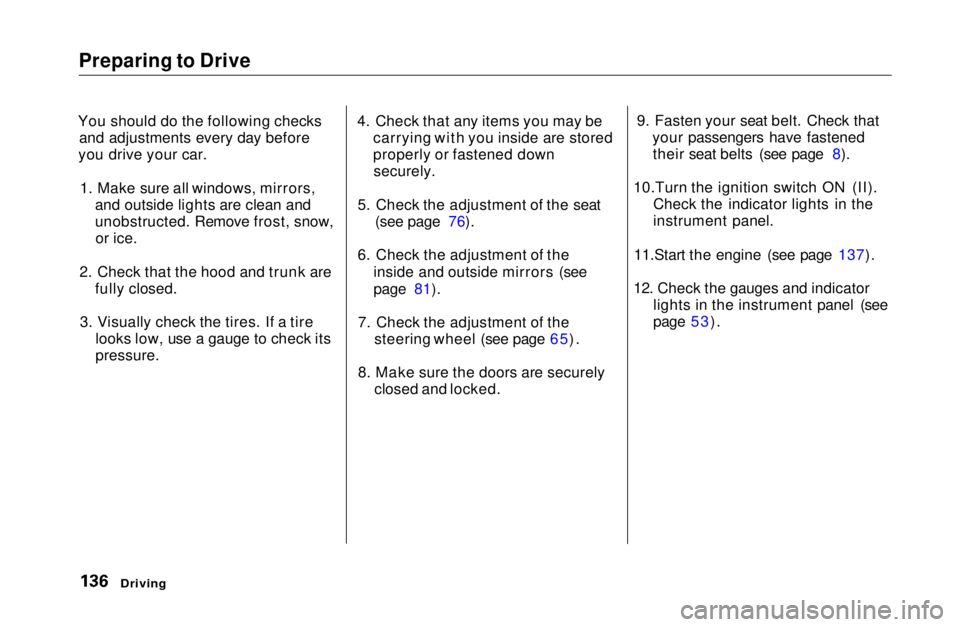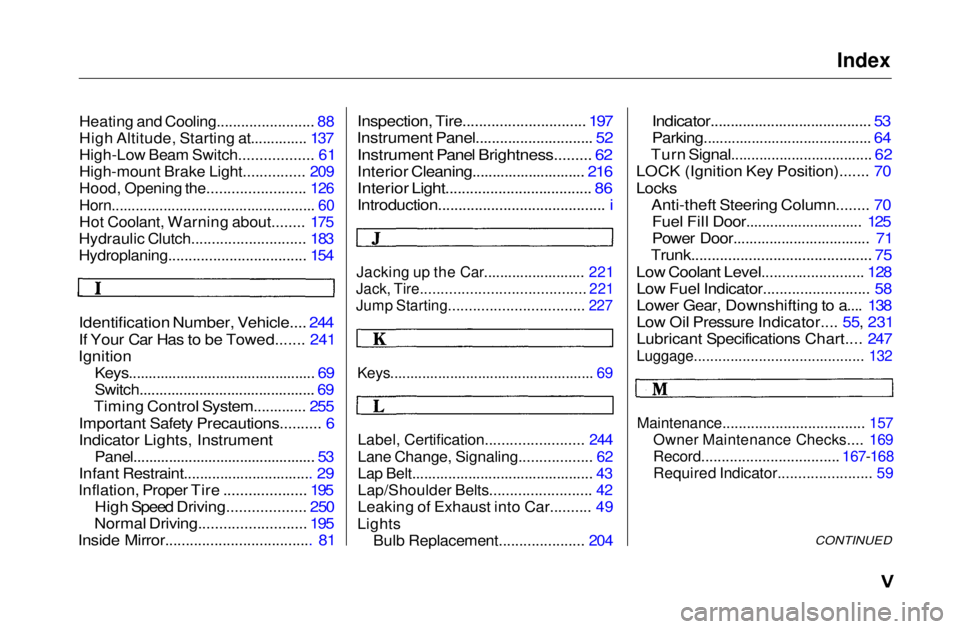Page 136 of 269

Preparing to Drive
You should do the following checks and adjustments every day before
you drive your car.
1. Make sure all windows, mirrors, and outside lights are clean and
unobstructed. Remove frost, snow,or ice.
2. Check that the hood and trunk are fully closed.
3. Visually check the tires. If a tire looks low, use a gauge to check its
pressure. 4. Check that any items you may be
carrying with you inside are stored
properly or fastened downsecurely.
5. Check the adjustment of the seat (see page 76).
6. Check the adjustment of the inside and outside mirrors (see
page 81).
7. Check the adjustment of the steering wheel (see page 65).
8. Make sure the doors are securely closed and locked. 9. Fasten your seat belt. Check that
your passengers have fastenedtheir seat belts (see page 8).
10.Turn the ignition switch ON (II). Check the indicator lights in the
instrument panel.
11.Start the engine (see page 137).
12. Check the gauges and indicator lights in the instrument panel (see
page 53).
DrivingMain Menu Table of Contents s t
Page 141 of 269
Automatic Transmission
Shift Lever Position Indicator
This indicator on the instrument panel shows which position the shift
lever is in.
The "D4" indicator comes on for a few seconds when you turn theignition switch ON (II). If it flashes
while driving (in any shift position), it indicates a possible problem in the
transmission. Avoid rapid acceler- ation and have the transmission
checked by an authorized Honda dealer as soon as possible.Shift Lever Positions
The shift lever has six positions. It
must be in Park or Neutral to start
the engine. When you are stopped inD4, D3, 2, N or R, press firmly on the
brake pedal, and keep your foot off
the accelerator pedal.
CONTINUED
Driving
SHIFT LEVERMain Menu Table of Contents s t
Page 146 of 269
Automatic Transmission (CVT)
Shift Lever Position Indicator
This indicator on the instrument panel shows which position the shift
lever is in.
The "D" indicator comes on for a few seconds when you turn theignition switch ON (II). If it flashes
while driving (in any shift position), it indicates a possible problem in the
transmission. Avoid rapid accelera-
tion and have the transmissionchecked by an authorized Honda
dealer as soon as possible. Shift Lever Positions
The shift lever has six positions. It must be in Park or Neutral to start
the engine. When you are stopped in
D, S, L, N or R, press firmly on the
brake pedal and keep your foot off the accelerator pedal.
DrivingMain Menu Table of Contents s t
Page 149 of 269

Parking
Always use the parking brake when
you park your car. The indicator on the instrument panel shows that theparking brake is not fully released; it
does not indicate that the parking
brake is firmly set. Make sure the parking brake is set firmly or your
car may roll if it is parked on an
incline.
If your car has an automatic
transmission, set the parking brake
before you put the transmission inPark. This keeps the car from
moving and putting pressure on the
parking mechanism in the
transmission — making it easier to
move the shift lever out of Park
when you want to drive away. If the car is facing uphill, turn the
front wheels away from the curb. If
you have a manual transmission, put it in first gear.
If the car is facing downhill, turn the
front wheels toward the curb. If you
have a manual transmission, put it in reverse gear.
Make sure the parking brake is fully
released before driving away.
Driving with the parking brake
partially set can overheat or damage
the rear brakes. Parking Tips Make sure the moonroof and the
windows are closed. Turn off the lights.
Place any packages, valuables, etc.,
in the trunk or take them with you. Lock the doors with the key or the
remote transmitter.
Never park over dry leaves, tall
grass, or other flammable materials. The three way catalytic
converter gets very hot, and could
cause these materials to catch on
fire.
DrivingMain Menu Table of Contents s t
Page 153 of 269
The Braking System
*U.S. indicator shown
The ABS is self-checking. It also checks itself whenever you use the
brakes.
If anything goes wrong, the ABS
indicator on the instrument panelcomes on (see page 55). This means
the anti-lock function of the braking system has shut down. The brakes
still work like a conventional system
without anti-lock, providing normal stopping ability. You should have the dealer inspect your car as soon as
possible if this light stays on after
you start the engine, or comes on
while driving.
Driving
ABS Indicator
ABS INDICATOR'Main Menu Table of Contents s t
Page 264 of 269

Index
Heating and Cooling........................ 88
High Altitude, Starting at.............. 137
High-Low Beam Switch.................. 61
High-mount Brake Light............... 209
Hood, Opening the........................ 126
Horn................................................... 60
Hot Coolant, Warning about........ 175
Hydraulic Clutch............................ 183
Hydroplaning.................................. 154
Identification Number, Vehicle.... 244
If Your Car Has to be Towed....... 241
Ignition
Keys............................................... 69
Switch............................................ 69
Timing Control System............. 255
Important Safety Precautions.......... 6
Indicator Lights, Instrument
Panel.............................................. 53
Infant Restraint................................ 29
Inflation, Proper Tire .................... 195
High Speed Driving................... 250
Normal Driving.......................... 195
Inside Mirror.................................... 81
Inspection, Tire.............................. 197
Instrument Panel............................. 52
Instrument Panel Brightness......... 62
Interior Cleaning............................ 216
Interior Light.................................... 86
Introduction......................................... i
Jacking up the Car......................... 221
Jack, Tire........................................ 221
Jump Starting................................. 227
Keys................................................... 69
Label, Certification........................ 244
Lane Change, Signaling.................. 62
Lap Belt............................................. 43
Lap/Shoulder Belts......................... 42
Leaking of Exhaust into Car.......... 49
Lights
Bulb Replacement..................... 204
Indicator........................................ 53
Parking.......................................... 64
Turn Signal................................... 62
LOCK (Ignition Key Position)....... 70
Locks
Anti-theft Steering Column........ 70Fuel Fill Door............................. 125
Power Door.................................. 71
Trunk............................................ 75
Low Coolant Level......................... 128 Low Fuel Indicator.......................... 58
Lower Gear, Downshifting to a.... 138
Low Oil Pressure Indicator.... 55, 231
Lubricant Specifications Chart.... 247
Luggage.......................................... 132
CONTINUED
Maintenance................................... 157
Owner Maintenance Checks.... 169
Record.................................. 167-168
Required Indicator....................... 59Main Menu s t